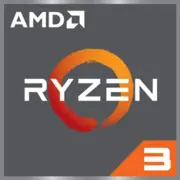AMD Ryzen 3 4300G (OEM Only)

AMD Ryzen 3 4300G (OEM Only): Complete Review of the 2025 Processor
April 2025
Key Specifications: Architecture and Performance
Zen 2 on 7 nm: Efficiency Above All
The AMD Ryzen 3 4300G is built on the Zen 2 architecture and is manufactured using TSMC's 7 nm FinFET process. This ensures a balance between energy efficiency and performance. With four cores supporting SMT (8 threads) and a base frequency of 3.8–4.0 GHz (in turbo mode), it is suitable for basic tasks.
Key Features:
- Integrated Radeon™ Graphics (Vega 6 with 6 CU) — allows for operation without a discrete graphics card.
- PCIe 4.0 Support — relevant for fast NVMe drives.
- Low TDP of 65W — minimizes heat and noise in the system.
Benchmark Performance (examples):
- Cinebench R23: 5400 points (multi-threading).
- CS:GO (1080p, medium settings): 60–80 FPS.
- 4K video in VLC/Plex: smooth decoding thanks to hardware acceleration.
Compatible Motherboards
AM4 Socket: Budget Platform with Potential
The Ryzen 3 4300G uses the AM4 socket, allowing for a wide range of motherboard options:
- Chipsets: A520 (budget), B550 (optimal), X570 (premium).
- Recommendations:
- ASRock B550M-HDV ($85) — supports PCIe 4.0, HDMI 2.1.
- Gigabyte A520M S2H ($70) — basic model for office PCs.
Important:
- To enable PCIe 4.0, B550/X570 chipsets are required.
- Update the BIOS to a version that supports Ryzen 4000G before purchasing.
Supported Memory
DDR4: Optimal Choice for Budget Builds
The processor works with DDR4:
- Frequencies: up to 3200 MHz (officially), but many motherboards support overclocking up to 3600 MHz.
- Modes: Dual-channel configuration (2×8 GB) is essential for maximum performance of the integrated graphics.
Example Configuration:
- Crucial Ballistix 16 GB (2×8 GB) DDR4-3200 — $45.
Power Supply Recommendations
65W TDP: Minimum Power — Maximum Possibilities
A system with the Ryzen 3 4300G without a discrete graphics card requires a PSU of 300–400W:
- Corsair CX450 (80+ Bronze) — $55 (reliable and quiet operation).
Tip: If planning to install a graphics card (e.g., Radeon RX 6600), choose a PSU of 500–600W (e.g., EVGA 600 GD — $70).
Pros and Cons
Strengths:
1. Energy efficiency — ideal for compact cases.
2. Integrated graphics — runs light games and handles multimedia processing.
3. Affordability — the OEM version costs around $100–120 (as part of complete PCs).
Weaknesses:
1. 4 cores — multitasking is limited (streaming or rendering may cause stuttering).
2. OEM supply — hard to buy separately (only through system integrators).
3. 4 MB L3 cache — less than the Ryzen 5 5600G (16 MB).
Use Case Scenarios
1. Office Tasks and Web Surfing
- Document work, browsers (20+ tabs), Zoom conferences — the processor handles these without complaints.
2. Multimedia and Home Theater
- Streaming 4K (Netflix, YouTube), HDR playback — hardware decoding of VP9 and HEVC.
3. Light Gaming
- Examples of FPS (1080p, low settings):
- Fortnite: 50–60 FPS.
- GTA V: 45–55 FPS.
Comparison with Competitors
1. Intel Core i3-13100F
- Price: $110 (without integrated graphics).
- Pros: Higher IPC, better in single-threaded tasks.
- Cons: Requires a separate graphics card.
2. AMD Ryzen 5 4600G
- Price: $150 (OEM).
- Pros: 6 cores, Vega 7.
- Cons: More expensive by 30%.
Conclusion: The Ryzen 3 4300G stands out among competitors mainly for budget constraints and the necessity for integrated graphics.
Practical Assembly Tips
1. Case Selection: Mini-ITX (e.g., Cooler Master MasterBox Q30L) for a compact system.
2. Cooling: The boxed Wraith Stealth cooler is adequate, but for quieter operation, consider the DeepCool Gammaxx 400 ($20).
3. Storage: An NVMe SSD is essential (e.g., Kingston NV2 500 GB — $35) for faster boot times.
4. Upgrade Path: Choose a motherboard that supports Ryzen 5000 (like B550) to later upgrade to Ryzen 7 5700X.
Final Verdict: Who Is the Ryzen 3 4300G For?
This processor is an ideal choice for:
- Budget Home PCs — for study, work, and media consumption.
- Compact Systems — HTPC or mini-PC in the living room.
- Beginner Users — those who are not ready to pay extra for excessive power.
Why it stands out? The combination of price, integrated graphics, and low power consumption makes the Ryzen 3 4300G unique in its category. However, for gaming or professional tasks, it’s better to consider the Ryzen 5 5600G or Intel Core i5-13400.
Basic
CPU Specifications
Memory Specifications
GPU Specifications
Miscellaneous
Share in social media
Or Link To Us
<a href="https://cputronic.com/cpu/amd-ryzen-3-4300g-oem-only" target="_blank">AMD Ryzen 3 4300G (OEM Only)</a>